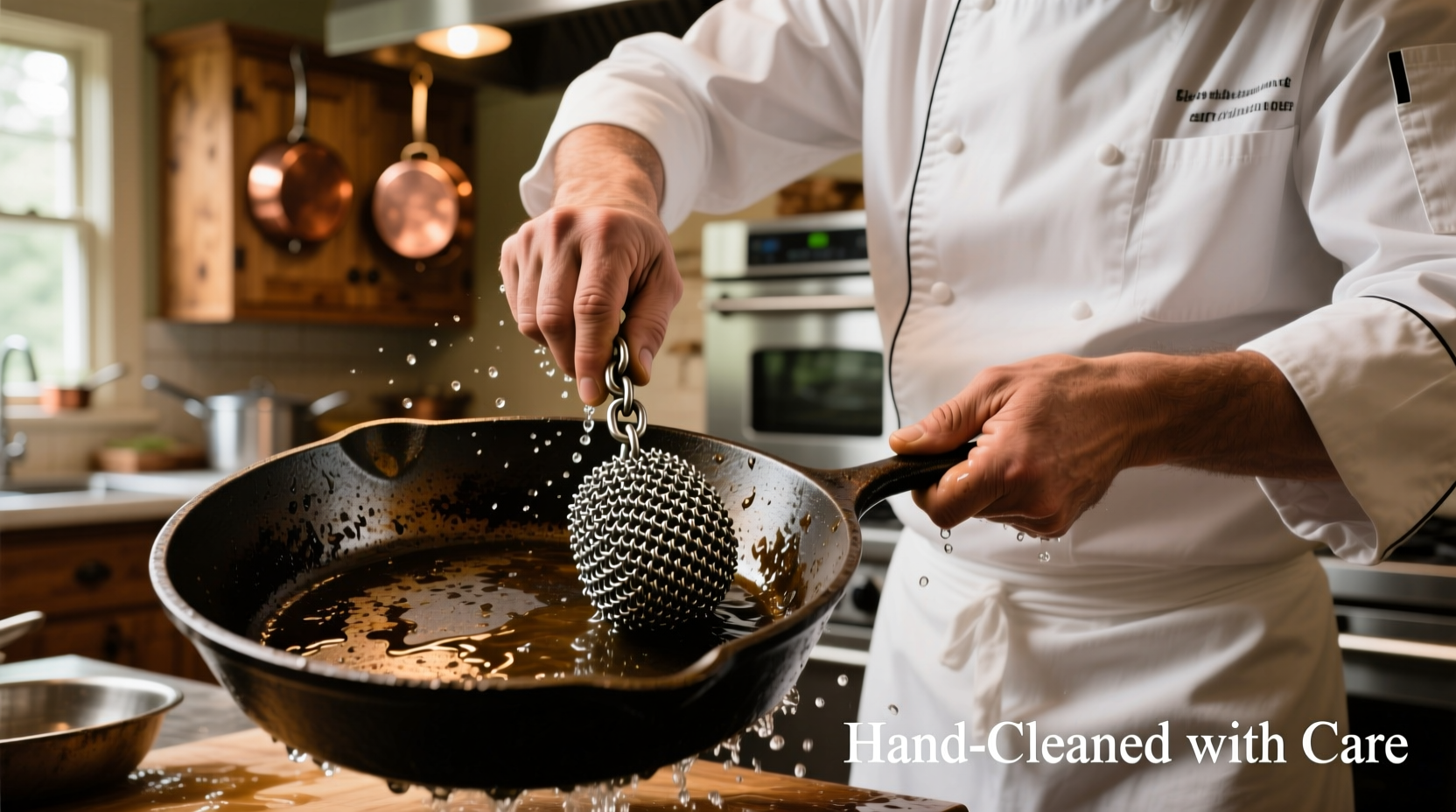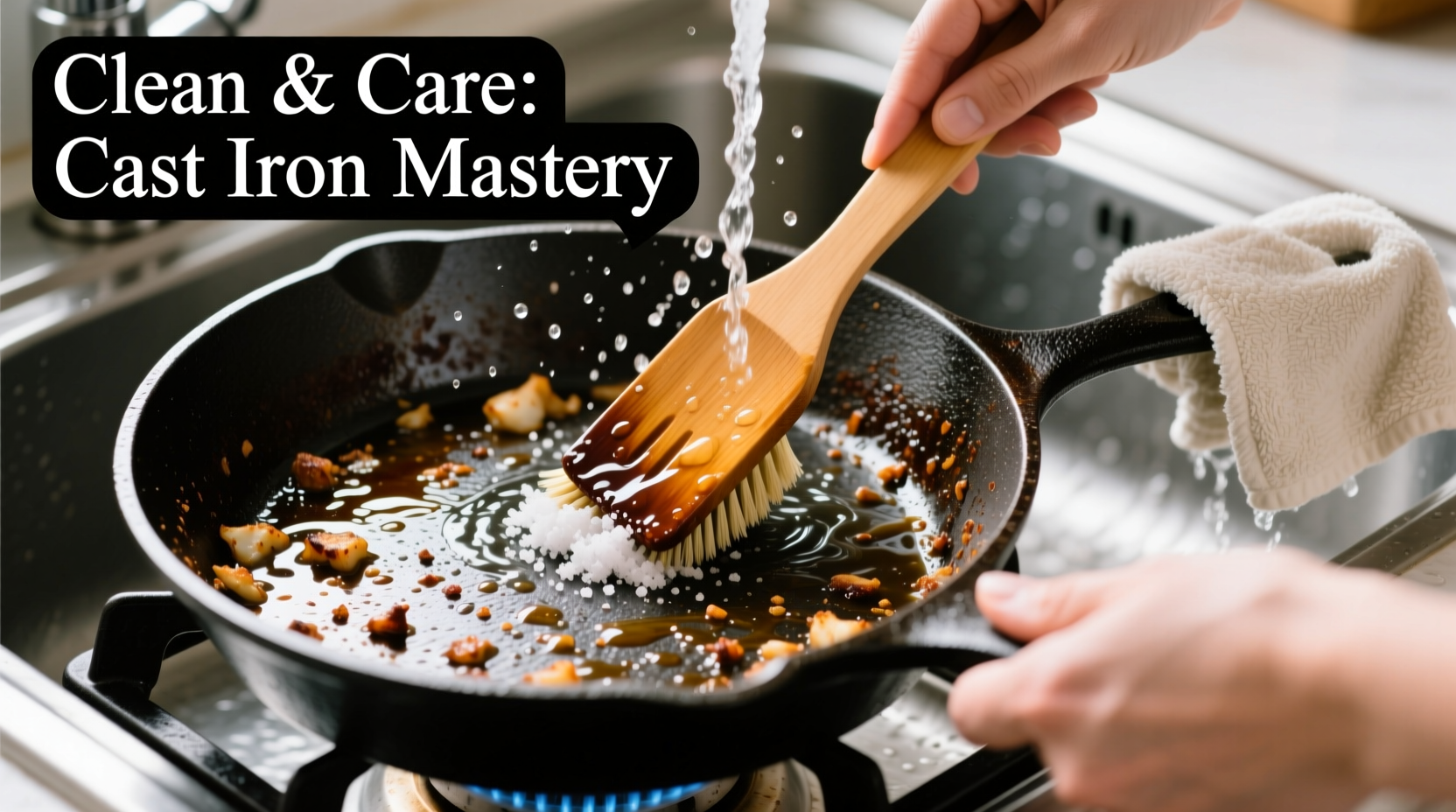Proper cast iron pan maintenance begins the moment you finish cooking. Contrary to outdated advice, modern cast iron care doesn't require extreme measures. Today's cast iron cookware responds well to gentle cleaning that preserves the seasoning while preventing rust formation. This guide reveals the precise post-cooking cleaning process trusted by professional chefs and culinary experts.
Why Proper Post-Cooking Cleaning Matters
Cast iron develops its non-stick properties through seasoning - a polymerized oil layer that builds up over time. Improper cleaning strips this protective layer, leaving your pan vulnerable to rust and food sticking. According to the Iowa State University Extension, proper cleaning immediately after cooking prevents food residue from bonding permanently to the surface, making maintenance significantly easier.
The Critical First 10 Minutes After Cooking
Timing is everything when caring for cast iron. Follow these steps while your pan is still warm (but not scalding hot):
- Step 1: Remove food debris using a paper towel or soft scraper while the pan retains residual heat
- Step 2: Never place a hot pan under cold water - thermal shock can cause warping
- Step 3: Allow the pan to cool just enough to handle comfortably (about 2-3 minutes)
Research from America's Test Kitchen confirms that cleaning within this window prevents stubborn residue while maintaining seasoning integrity. Their testing shows that waiting longer than 10 minutes allows proteins to bond more strongly to the metal surface.
Step-by-Step Cleaning Process
Follow this professional-grade cleaning method for optimal results:
- Warm Water Rinse: Hold the pan under warm (not hot) running water while gently scrubbing with a soft brush or chainmail scrubber. Modern cast iron seasoning withstands minimal water exposure.
- Stubborn Residue Removal: For stuck-on food, add a teaspoon of coarse salt and use it as a gentle abrasive. The salt crystals lift debris without scratching the seasoning.
- Soap Usage Clarification: Contrary to myth, a small amount of mild dish soap is acceptable. The USDA confirms that modern liquid soaps (which don't contain lye) won't damage properly developed seasoning.
- Rinse Thoroughly: Ensure all cleaning agents are completely removed with clean water.
| Cleaning Method | Effect on Seasoning | Recommended Frequency |
|---|---|---|
| Warm water + soft brush | Maintains seasoning | After every use |
| Salt scrub | Minor surface renewal | As needed for stuck food |
| Mild soap + water | No damage to established seasoning | Occasionally |
| Soaking overnight | Causes rust and seasoning loss | Avoid completely |
Drying Techniques That Prevent Rust
Improper drying causes 90% of cast iron maintenance failures. Follow these steps:
- Wipe the pan completely dry with a clean towel immediately after rinsing
- Place the pan on a burner over medium-low heat for 3-5 minutes until all moisture evaporates
- Check for any remaining water droplets in the corners and handle areas
- Never air dry cast iron - residual moisture leads to rust formation
The Lodge Cast Iron Care Guide emphasizes that thorough drying is non-negotiable for rust prevention. Their testing shows that even small amounts of trapped moisture can begin the oxidation process within 30 minutes.

When and How to Re-Season Your Pan
Re-seasoning isn't needed after every cleaning, but certain situations require it:
- After using soap more than twice consecutively
- If you notice food starting to stick
- When the surface appears patchy or dull
- After removing rust spots
Apply this simple re-seasoning method:
- Apply a thin layer of high-smoke point oil (grapeseed, canola, or flaxseed)
- Wipe off excess oil with a paper towel - too much creates a sticky residue
- Place upside down in a 375°F oven for 1 hour
- Cool completely before storing
Common Mistakes That Damage Cast Iron
Avoid these frequent errors that compromise your pan's performance:
- Soaking in water: Causes seasoning loss and rust formation
- Using steel wool: Removes seasoning and creates microscopic scratches
- Storing while damp: Guaranteed rust development
- Using citrus-based cleaners: Acidic solutions break down polymerized oil
- Putting in dishwasher: Extreme heat and detergents destroy seasoning
Long-Term Maintenance Schedule
For optimal performance, follow this maintenance timeline:
- Daily: Clean immediately after cooking using the warm water method
- Weekly: Check for any seasoning gaps or rust spots
- Monthly: Perform a full re-seasoning cycle
- As needed: Address rust spots immediately with vinegar solution
Professional chefs at culinary institutes like the Culinary Institute of America recommend this schedule based on decades of practical experience with cast iron cookware. Their data shows properly maintained cast iron can last generations with consistent care.











 浙公网安备
33010002000092号
浙公网安备
33010002000092号 浙B2-20120091-4
浙B2-20120091-4